![]()
![]()
![]()
Use LEFT and RIGHT arrow keys to navigate between flashcards;
Use UP and DOWN arrow keys to flip the card;
H to show hint;
A reads text to speech;
27 Cards in this Set
- Front
- Back

|
Painted Catacomb Ceiling
-Early Christian 1. Catacombs=underground burial site 2. This is a fresco painting. 3. This is an artistic-shorthand. |
|
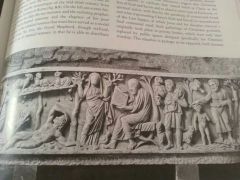
|
Sarcophagus from Santa Maria Antiqua
-Early Christian 1. Coffin covered in relief sculpture. 2. People would rub the face of the orang for good luck. 3. The Good Shepherd, Jonah, and the Philosopher are also shown. |
|
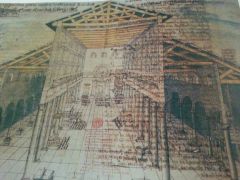
|
Reconstruction Drawings of Old St.Peter's Rome
-Early Christian 1. Represents the beginning of the Institution of Christianity. 2. Built with Imperial money. 3. This church was based on a previous Roman building, the basilica. |
|

|
Mausoleum of Galla Placidia AND Christ as the Good Shepherd mosaic
-Early Christian 1. The centralized building has a plain exterior, but the interior is richly decorated in mosaics. 2. This represented that a Christian would be plain on the exterior, but their inner self would be the focus. 3. Christ is shown in seated contrapposto. |
|
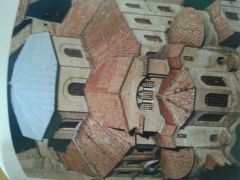
|
San Vitale at Ravenna
-Byzantine 1. The exterior is plain while the interior is highly decorated. 2. Mosaics were the most popular art form in the Byzantine Empire. 3. Large windows allow for the interior to be flooded with light. |
|
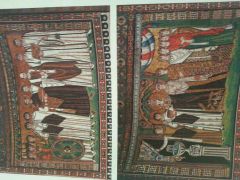
|
Justinian and Attendants AND Theodora and Attendants, from S. Vitale
-Byzantine 1. Justinian and Theodora both have halos, indicating their holy status. 2. Justinian is surrounded by soldiers and priests, indicating he is head of both Church and State. 3. Theodora died shortly after the completion of this mosaic. |
|

|
Hagia Sophia
-Byzantine 1. Hagia Sophia means "Holy Wisdom." 2. This building was designed by mathematicians. 3. This was the imperial church of Justinian and Theodora, and was not open to the public. |
|
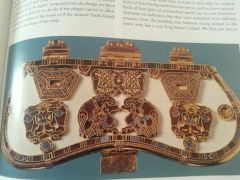
|
Purse cover from the Sutton Hoo ship burial.
-Early Medieval 1. Each of four pairs of symmetrical motifs has its own distinctive character. 2. This indicates that they were assembled from different sources. 3. The purse itself was probably a leather pouch. |
|

|
Symbol of St. Matthew from Book of Durrow
-Early Medieval 1. Shows how ornamental pattern can animate a figure. 2. These elaborate patterns are used here to show that St. Matthew's message is precious. 3. These decorative patterns recall the ornamental quality of the Sutton Hoo clasps. |
|
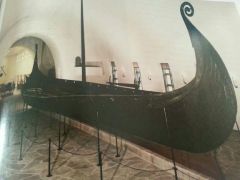
|
Burial Ship from Oseburg
-Early Medieval 1. Burying important people in ships originated in Scandinavia. 2. More than 75 ft long. 3. This boat was used for the pleasure of sailing calm waters. |
|
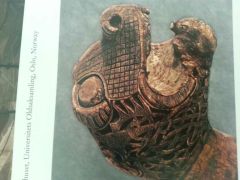
|
Animal Head Ship's Prow
-Early Medieval 1. Their actual function is not known. 2. It has been suggested that they were carried in processions or used in cult functions. 3. Has both realistic qualities and interlacing and geometric forms. |
|
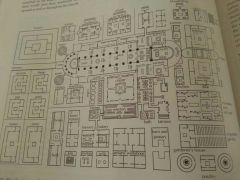
|
Plan of the Monastery
-Carolingian 1. 2. 3. |
|
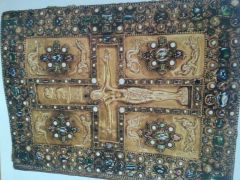
|
Book Cover (Lindau Gospels)
-Carolingian 1. 2. 3. |
|
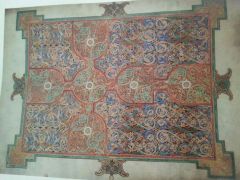
|
Carpet Page from the Lindesfarne Durrow
-Early Medieval 1. A compass and a ruler were used to mark the page with a network of grid lines with points. 2. Considered "a sort of a sacred riddle." 3. The beauty of the cover should reflect the importance of its contents. |
|

|
The Palatine Chapel at Achen
-Carolingian 1. Probably inspired by the church of San Vitale in Ravenna. 2. Designed by Odo of Metz. 3. Einhard, Charlemagne's trusted advisor and biographer, supervised the project. |
|
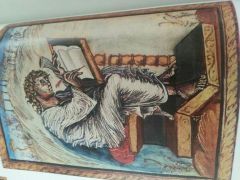
|
St. Matthew from the Ebbo Gospels
-Carolingian 1. Filled with vibrant energy that sets everything in motion. 2. The artist communicated this energy mostly through the use of flickering line. 3. This image reflects The Gospel Book of Charlemagne. |
|

|
St. Michael's in Hildesheim
-Ottonian 1. Architect: Bernward 2. Plan derived from Saint-Riquier at Centula 3. Also has similarities to the monostary church of St.Gall plan. |
|
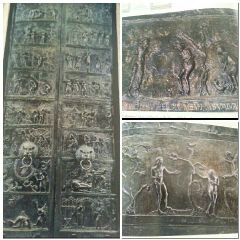
|
Bronze doors for St. Michael's
-Ottonian 1. Bishop Bernward was probably involved in making these doors. 2. The doors were probably influenced by similar ones seen in Rome. 3. Considered the first monumental sculptures created by the lost-wax process since antiquity. |
|
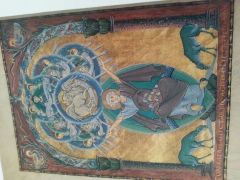
|
St. Luke from the Gospel book of Otto iii
-Ottonian 1. Unlike Carolingian manuscripts, St. Luke is not shown writing. 2. The inscription means "From the sources of the fathers the ox brings forth a flow of water for the lambs." 3. This is a symbolic image of overwhelming grandeur despite its small size. |
|
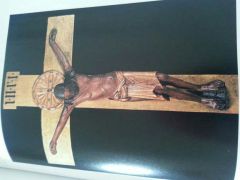
|
The Gero Crucifix
-Ottonian 1. Life-size 2. The first time Christ is shown dead on a Cross. 3. Painted and guilded oak carved in fully rounded forms. |
|
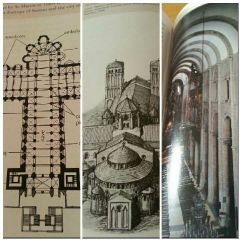
|
Santiago de Compostela
-Romanesque 1. Considered a Pilgrimage Plan Church. 2. Santiago is Spanish for James (the apostle). 3. The tomb was thought to have miraculous power, which attracted many pilgrims from all over Europe. |
|

|
Foot Reliquary
-Romanesque 1. A Reliquary box holds physical remains of religious figures, such as their bones. 2. Metalwork technique used. 3. Foot on top represents the importance of pilgrimage. |
|
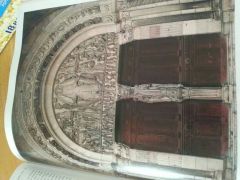
|
Tympanum of Autun
-Romanesque 1. Sculptor: Gislebertus 2. Represents the Last Judgement. 3. Hierarchical scale is used to show Christ. |
|
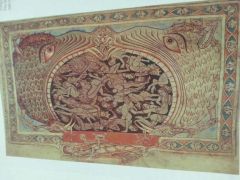
|
Mouth of Hell
-Romanesque 1. The inscription translates to "Here is Hell and the angels who lock the doors." 2. This monster devours sinners from all classes. 3. The heavily outlined frame encloses and controls the frightening image. |
|
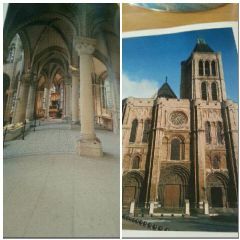
|
St. Denis
-Gothic 1. Considered the first Gothic style church. 2. Abbot Suger: inventor of the Gothic Style 3. Abbot Suger wanted to create God's kingdom of Heaven on Earth. |
|
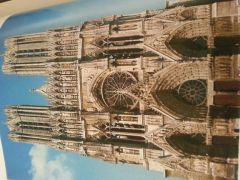
|
Reim's Cathedral
-Gothic 1. Ex. of "High Gothic" style. 2. These churches were dedicated to Notre Dame (="our lady"/ "the Rose") 3. One of the French churches that was important to the Royal family. |
|
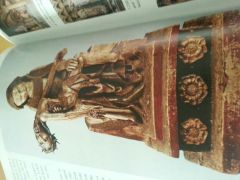
|
Roettgen Pieta
-Gothic 1. Pieta is a term for the virgin Mary holding the body of Christ. 2. This is a small wooden sculpture. 3. The focus is not proportions, but the expressions showing the suffering of Christ and the virgin Mary mourning over him. |

